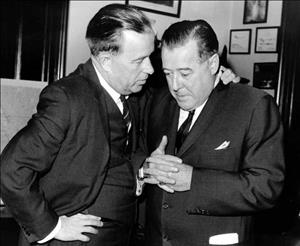On April 16, 1969, Senator Henry M. Jackson (1912-1983) conducts the first U.S. Senate hearing on the National Environmental Policy Act (NEPA). Jackson takes the opportunity to explain his reasons for introducing this sweeping piece of environmental legislation. The concept of the Environmental Impact Statement is first broached during this hearing, but will not be added to the bill until later. It will easily pass the U.S. Senate and the House in December 1969 and will be signed into law on January 1, 1970, by President Richard M. Nixon (1913-1994). It will become one of the most influential environmental laws in U.S. history.
Jackson's Senate Interior Committee
Jackson, the chairman of the Senate Interior and Insular Affairs Committee, had been working with his staff on the idea of an environmental policy bill since 1968. A number of important environmental bills had already emerged from Jackson's committee -- including the Wilderness Act of 1964 and the Wild and Scenic Rivers Act of 1968. Yet Jackson wanted to set forth a comprehensive national policy on the environment, and he wanted to ensure that federal agencies would take the environment into consideration whenever they proposed a major project.
He had introduced the bill in the Senate in February, but the hearings on April 16 were the first -- and only -- hearings he would hold on the bill in the Senate. The bill had attracted little notice or opposition -- and Jackson didn't mind keeping it that way.
On the Senate floor that day, he took the opportunity to describe his motivations and aspirations for this bill:
"I introduced this bill because it is my view that our present knowledge, our established policies, and our existing institutions are not adequate to deal with the growing environmental problems and crises the nation faces. The inadequacy of present knowledge, policies and institutions is reflected in our nation's history, in our national attitudes, and in our contemporary life. We see this inadequacy all around us: haphazard urban growth, the loss of open spaces, strip-mining, air and water pollution, soil erosion, deforestation, faltering transportation systems, a proliferation of pesticides and chemicals, and a landscape cluttered with billboards, powerlines, and junkyards.
"Traditional government policies and programs weren't designed to achieve these conditions. But they weren't designed to avoid them, either. And, as a result, they were never avoided.
"As a nation, we have failed to design and implement a national environmental policy which would enable us to weigh alternatives, and to anticipate the undesirable side effects which often result from our ongoing policies, programs and actions. Today it is clear that we cannot continue to perpetuate the mistakes of the past. We no longer have the margins for error and mistake that we once enjoyed. It was in view of this background and these considerations that I introduced S. 1075, my bill to establish a national environmental policy" (Caldwell, p. 1-2).
Environmental Impact Statement
This hearing also had another significant moment, even though few recognized it at the time. It came when Lynton K. Caldwell, a consultant for Jackson's Interior Committee and one of the architects of the bill, spoke in response to a question from Jackson.
"I said that a declaration of environmental policy must be operational to be effective -- written so that its principles could not be ignored," said Caldwell in a 1998 book about NEPA. "I urged that a statement of policy by the Congress should at least consider measures to require federal agencies in submitting their proposals, to contain within the proposals an evaluation of their effect upon the state of the environment" (Caldwell, p. 29).
It was, he later said, "the introduction of the concept of an environmental impact statement." (Caldwell, p. 29).
A New Direction
The bill itself did not have such a provision yet. The committee's staff "had been contemplating a need for such a mechanism and the Caldwell testimony lent new impetus to their considerations" (Liroff, p. 16). Jackson himself said at the hearings that without some kind of action-forcing mechanism, "these lofty declarations are nothing more than that" (Caldwell, p, 48). The environmental impact statement provision would be written into the bill later, as part of a series of changes and compromises as the legislation moved through the Senate and House.
After the bill was signed into law on January 1, 1970, the Environmental Impact Statement provision would become the most famous of the NEPA's provisions. However, NEPA also accomplished a less tangible goal that Jackson laid out during that April hearing: To steer the country in a new direction, away from the environmental "mistakes of the past."

